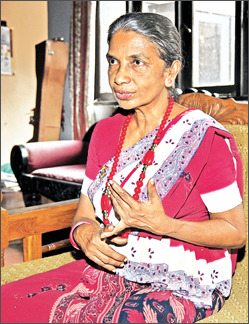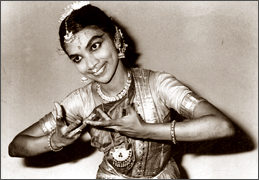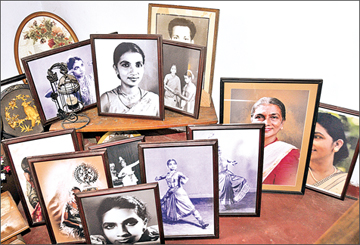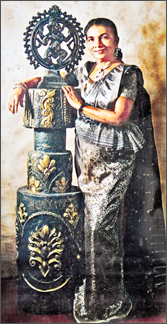Dance to your heart’s content
Miranda Hemalatha on her trailblazing career as a
dancer:
Jayanthi Liyanage
|

Miranda Hemalatha.
Pictures by Saman Sri Wedage
|
|

During a performance
|
Award winning dancer, actress, choreographer, director of drama,
Miranda Hemalatha is the first Director of Asthetic Education in Sri
Lanka. She has been very articulate about the discrepancies in the dance
education system and expressed some of her views for the Daily News.
She was the first to ordain women dancers with the Ves costume,
indicating there should be no discrimination for men or women where the
dignity of dance is concerned, and went on to ordain 51 women. She holds
the distinction of having held the 104th Arangetram of her dance
students.
Her Diri Daru Piyasa for Down’s Syndrome children created a sensation
when Kosala and Yasas presented Diriya Narthana on stage. Her first
Down’s Syndrome female student to dance is now a teacher in a school.
Going to India as the first Colombo Plan scholar in 1963, Miranda’s
Arangetram in India had been organized by the leading Indian musician
Maturai Krishnon.
Q: What are your current activities?
A:We are getting ready for the next Arts Festival. Once in every five
years, we have a festival. We have panels and discussions which really
the Arts Council of the Cultural Ministry should do. But unfortunately
in Sri Lanka such things do not happen. In Sri Lanka, the money that the
Government gives for the development of arts does not go to correct
people. A few people distribute it among themselves. So nothing happens
especially in the fields of arts.
Q:What do you think of the position of dance in Sri Lanka?
A:We saw on a TV channel on international women’s day, a semi-nude
dancing and a teacher talking about the culture. The cost of that item
was Rs. 175,000. Why not distribute that money among a number of
teachers so they all get a chance to show their talent? This is a
monopoly. Traditional arts is a national wealth. What does Cultural
Ministry do? You can’t blame the Government of course. Officers of Arts
Council and Dance Panel should be held responsible for this.

Miranda’s pictures of yesteryear

With her students |
|

Miranda the dancer |
In Sri Lanka you cannot accept all the lecturers of the Fine Arts
University as veterans. Once the student intake was with Senior School
Certificate (GCE O/L). Now they have got MAs and PhDs but not for dance.
In any country, the national identity depends on the national arts. In
Sri Lanka it is dance.
Other than folk songs, we don’t have Sinhala music as such. It is a
mixture of Hindustani and Western music. But Kandyan, Sabaragamuwa and
Low Country dance is a national identity. Traditional arts are the sole
responsibility of Cultural, Education and Youth Services Ministries.
There is no co-ordination among the Ministries. Each Ministry organizes
competitions for school children without coming to an agreement. There
is such a lot of youth who have taken to dancing, music and art but who
are not recognized.
Q:What are your experiences as a dancer and an educationist?
A:When I was a dancer and came back from India, I was at the highest
point of my popularity. In India, the press introduced me as the golden
creeper from Ceylon giving superlative performances. There was a press
group in Sri Lanka who had really loved arts such as Sriya Ratnakara and
Sybil Wettasinghe, so they came to us. I was the first to dance for the
Sarasavi song at the Sarasaviya Festival.
I served in the field of aesthetic education and gave respect and
dignity to the teachers.
|

Publications about Miranda |
I corrected all the mess in the A/L and O/L. When I took over, it
took months to do the practical test. As soon as I took over, I made it
five days, and the whole country did the practical exam at the same
time. I never allowed teachers from one area to test children from the
same area. I never sent one teacher twice to one area. I made exams
respectful and trustworthy.
Foreigners have commented about my exam papers and wanted to know how
I managed it. Now, standards of dance exam papers have gone down. In
1957, As a student of College of Fine Arts, I sat on the steps of the
old Parliament saying I would not get up until the Prime Minister comes.
The end product of that was the Kularatne commission.
It recommended that the College be made a University and from the
first batch, they should get a degree certificate. I fought for 24 years
to get that certificate recognized by the Government as a degree and got
it done in 1984. As a result all the teachers who had this certificate
could do their Masters. When I wrote my final report for the committee,
I was in a hospital bed with both arms fractured in an accident.
Q:How should the position of dance in the country be improved?
A:Today it is on the verge of collapse. In the school system, the
practical tests and syllabii, teachers’ manuals have some problems. Some
of the officers who write teachers’ manuals have third class degrees in
dancing. How can you make people with third class degree responsible for
the nation’s education? To get promotions, many of them did MAs in Mass
Media. But that has nothing to do with dancing. Whoever comes as the
Education Minister has a big problem to reform the educational setup,
teacher training programs and school system.
Teachers are overloaded with other work and have no time to teach. I
was made to understand that teacher educators have very little to do
with curriculum developers. I was in the ministry for 37 years, in the
teacher education department for 16 years, and in administrative service
for 15 years. From my directorship, I retired early. Had I stayed on for
another five years, this down fall of aesthetic education would not have
happened. I hope the new government will not repeat the mistakes.
Q:What changes did you make to the A/L curriculum?
A:I was the first one to write ‘Objectives for Dance Education’ in
the dance syllabus in 1985.. I gave it some vision based on which we
drafted the syllabus. In 1993, when I took over aesthetic syllabuses of
dance, music, art and drama, I appointed a committee of people like Dr.
Sarachchandra, educationists and performing artistes. Now students have
to do five vannams for whole five years.
We introduced dance for a song. I saw that we did not have people for
a dance drama. I thought if we get the embryo form of it in the class
room, some of the students could be made dance actors. Now they have
deleted that unit. But in the music syllabus, they have to dance for a
song. Education values are not understood.
We do not produce dancers but dancer lovers, from the classroom. You
must develop the appreciation capacity of the nation. To do that, you
have teach performing, theory, and cultural history. Unfortunately,
media is catering to sex.
As a result of the report written on 1971 uprising, emphasis on
aesthetic education was made. I went to New Zealand for an international
seminar on dance in 1985 and read a report about the implementation of
the primary aesthetic syllabus in Sri Lanka. Professors came from other
universities and said that we were fifty years ahead of other countries.
Can you say the same thing now? |



